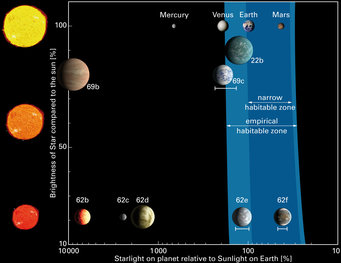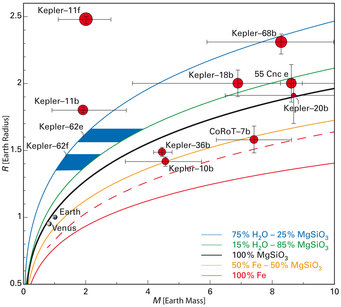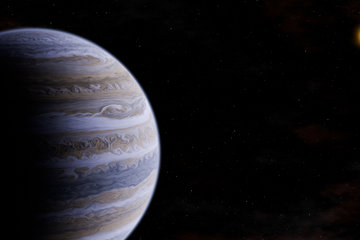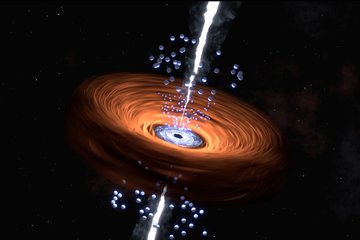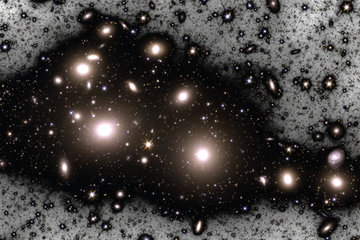Two second Earths
Astronomers have discovered two exoplanets in the constellation of Lyra where habitable conditions probably exist

Kepler-62 is in the constellation Lyra, at a distance of 1200 light-years from Earth. It is a star slightly smaller and cooler than our own Sun (spectral type K2V, estimated mass 0.7 solar masses, estimated radius: 0.63 solar radii). From the point of view of an observer on Earth, the stellar system is oriented in such a way that its planets periodically pass in front of their host star, blocking a tiny fraction of its light. The Kepler Space Telescope used the transit method to detect this effect in discovering the objects. By measuring extremely small variations in brightness, the space-based telescope located a total of five planets, named Kepler-62b to Kepler-62f.
An important aspect in researching exoplanets is the search for celestial bodies where the right conditions for supporting life could be present – a key step towards the goal of actually detecting life on other planets. It is in this respect that the newly discovered planets Kepler-62e and Kepler-62f are interesting.
“Kepler-62e and Kepler-62f are actually located in the habitable zone of their host star. In addition, they are the smallest bodies in this type of zone that have been located to date”, says Lisa Kaltenegger. The researcher at the Max Planck Institute for Astronomy is not a member of the Kepler team, but was responsible for estimating the potential habitability of both planets.
“Up to now, all of the interesting planets in habitable zones have been detected using what is known as the radial velocity method”, says Kaltenegger. “This method inherently provides a lower limit for a planet’s mass, but no information about its radius. However, it is difficult to judge just from the mass whether a planet is Earth-like, meaning a planet with a solid surface.” On the other hand, a radius of less than twice the Earth’s is a strong indication that it is Earth-like – unless a planet orbiting a very young star is being observed.

A key aspect of the discovery is that Kepler-62e and Kepler-62f are indeed rocky with solid surfaces and are not gas planets, like Jupiter or Neptune. The most interesting confirmed candidates for habitable planets (GJ 667Cc, Gl 581d, HD 85512b und Gl 163c) were all detected with the radial velocity method, which only allows conclusions about the lower limit of the mass of the planet being observed.
The actual mass of the planet is probably between this minimum mass and twice it, in most cases. For the candidates mentioned, this could mean that they are rocky planets, but they also could be miniature versions of Neptune. One good example of this is Kepler-11f, a mini-Neptune with a mass of 2.3 Earth masses and 2.6 times the Earth’s radius.
But that’s not all. According to Lisa Kaltenegger, the predictions about the habitability of a planet always depend on additional assumptions. “Let us assume that Kepler-62e and Kepler-62f are both rocky planets, as suggested by their radii. Let us further assume that there is water on these planets and that their atmospheres have a similar composition to that on Earth – primarily nitrogen with fractions of water vapour and carbon dioxide”, says Kaltenegger. “Under these conditions, water, in its liquid form, could exist on the surfaces of both planets.”
Kepler-62f receives less radiant energy from its sun than the Earth does from our own sun and would require more greenhouse gases (carbon monoxide, for instance), in order not to freeze. Kepler-62e is closer to its sun and needs a sufficiently dense cloud cover to reflect a portion of the solar radiation, if water is to exist on its surface in liquid form.
Scientists judge whether a planet is habitable or not based on whether water can exist in liquid form – the prerequisite for life as we know it. Whether it is habitable in the astronomical sense (i.e. lies in the habitable zone of its star) is a somewhat more stringent criterion – it requires that water be present in liquid form on the surface of the planet. That is the prerequisite for perhaps being able in future to detect life on such a planet with the aid of astronomical observations.
Habitability does not necessarily mean that a given planet appears like Earth in every detail. To the contrary: planets with sufficiently larger radii than the Earth, such as Kepler-62e and Kepler-62f, would probably be, if they have the same chemical composition as Earth, watery worlds covered by deep global oceans.
The result of the research does not prove that the given planet is actually “inhabited”, instead only that it could be – if the atmospheric conditions allow. Definitive proof is still a long way off. This can only be established if spectroscopic analyses of the planetary atmospheres become possible using telescopes larger than those currently available, that is if a sort of “chemical fingerprint” can be obtained.
An important part of the work by Lisa Kaltenegger and her colleagues is the modelling of how chemical fingerprints could look from certain kinds of planets, like Kepler-62e and Kepler-62f. In any event, Kepler-62e and Kepler-62f are the most promising candidates that we know of so far.
HOR / MP /MF
